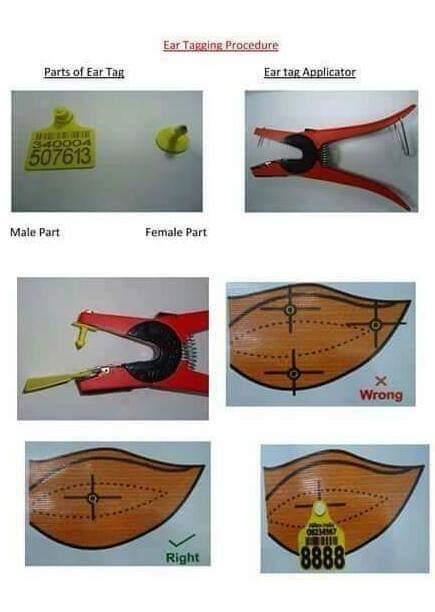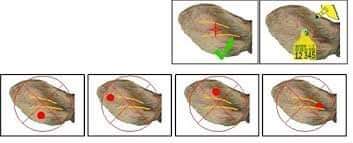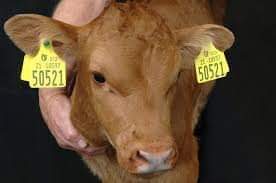PROCEDURE FOR TAGGING CATTLE PROPERLY
Ear tagging is very important especially if you are raising many cattle in your herd. It is an important part of animal identification. Because if you tag cattle, then it will be very helpful for you to easily identify the animal and keep records of those. Ear tagging also help the farmer to keep track and record information about the animal such as age, weight, gender, when a cow last calved, number of calves she had etc.
It is very important to tag cattle properly to avoid infection or tag lose. So, you must understand the importance of placement, identification, precautions and use of the tag applicator to tag a cow properly. There are actually 3 important tools to use when placing an ear tag. And these 3 tools are the applicator, stud and button. You can easily avoid complications if you know how to properly use these components.
Tags are an essential identification tool that can carry a variety of information and help both farmers and ranchers in their farm operations.
There are many critical management practices that are necessary to efficiently run a cattle operation. Ear tagging is an essential part of farm or ranch procedures and can aid in identification. It is important to use this practice properly to avoid infection or tag lose. To properly tag a cow or calf one must understand the importance of placement, identification, precautions, and use of the tag applicator.
Ear tags help us to keep track and record information such as gender, age, weight, when a cow last calved, number of calves she has had, etc. There are three important tools to use when placing an ear tag; the applicator, stud, and button. Knowing how to properly use these components will aid in avoiding complications. Tags are an essential identification tool that can carry a variety of information and help both farmers and ranchers in their operations. When applying a tag, reduced head movement will aid in assuring that the tag is placed in the correct position. Management of the applicator is also important, and one must know how to properly use and clean this tool.

General advice for cattle ear tag fitting
All calves must be tagged with an approved eartag in each ear within 20 days of birth. In the case of dairy animals, at least one of the tags must be fitted within 36 hours of birth. Complete and send in the corresponding passport application form to BCMS within 7 days of tagging. If an ear tag has become illegible or been lost it must be replaced within 28 days of the discovery.
In order to minimize tag losses make sure you use the correct applicator for the model of tag you are fitting. It also helps if you, where possible, try to remove such objects which may catch or pull out tags.
Secure the animal’s head to prevent jerking and continue as follows:
- Start with the primary tag. It may be applied in either ear. Separate the male part from the female.
- Place the male part firmly on the applicator pin.
- Push the female part under the tongue into the jaw of the applicator. Make sure the parts line up correctly on the applicator and will lock together when correctly fitted.
- Disinfect
- Place the male part of the tag on to the back of the ear with the female to the inner ear. The tip of the male part should be in the centre of the ear, between the ridges of cartilage avoiding any obvious veins. Squeeze the applicator firmly together.
- Rotate the tag to the right and the left to ensure free movement.
Secondary tags
Repeat procedure with the secondary tag in the other ear. Ensure that the secondary tag bears the same number as the primary tag.
Metal tags
When fitting metal tags to calves choose a location at the top of the ear about 1/3 from the head. Leave enough space (1/3 inch) under the fold of the tag to allow for ear growth. The ‘curl lock’ should be positioned in the inside (front) of the ear.

Step 1: Catching and Restricting Movement
Before an ear tag can be applied the animal must be caught and restrained to limit head movement and ensure accurate tag position. When a new calf is born their mother’s instinct is to protect them and this is a very helpful sense. However, when it comes to a handler ensuring that the calf gets the necessary attention, it can become dangerous. This is where a calf cage can be helpful. This tool allows the calf to be caught, cared for, and tagged without putting any individuals at risk of injury. Many times a single individual is able to secure the calf to be tagged without help. As the livestock gets older a head gate is required. This allows the animal’s head to be secured and the individual tagging to be out of harm’s way.
Step 2: Significance or Ear Tag Color
Ear Tag Color
The main reason for using ear tags is to better our ability to identify our livestock. When it comes to the color of tag producers use, there is great significance. Not only is the color important, but the ear that is tagged can also have significant meaning. Each farm can decide on their own method for identifying their cows. For example, a rancher may decide that an orange tag signifies a heifer while a yellow tag signifies a steer, or left ear signifies heifer while right signifies steer. Many combinations can be established with a multitude of meanings. The color and ear choice rely solely on the producer’s preferences, however when a choice has been made it is best to stick with it throughout each herd owned.
Step 3: Significance of Identification Number
Identification Number
Another identification tool is assigning a number to each animal. In many operations, there is only a number on each tag but sire, dam, and date of birth can also be added. Numbers are given to help with cattle inventory and are necessary for recording data for different circumstances. With older cows, it can help to identify the approximate breeding date, calving date, health and medical records, calving history, and possibly which pasture she is located. Numbers are used on calves to identify which cow it belongs to, date of birth, vaccinations, and any other concerns. It is important to label clearly and to write the animals identification information as large as possible so that it can be viewed from a distance. When writing on a tag be sure to use a designated tagging marker, regular and permanent markers fade with time and become hard to read.
Step 4: Tag Placement
Once a cow or calf has been chosen, colors are picked, and the identification information is on the tag it is time to start the process. If placed incorrectly, a tag could potentially cause problems, therefore location is very important. The ideal location to place an ear tag is in the middle one-third of the ear. The location should be between the rises in auricular cartilage or the ribs. If a tag is placed too far towards the inside of the ear it will fit tightly due to the presence of thicker cartilage. This may also cause necrosis, the death of cells in the tissue, or sloughing tissue which is the shedding of dead cells. Tags placed too far to the outside of the ear have the possibility to be snagged or ripped out. Proper tag placement is also important to reduce the risk of infection
Step 5: Proper Use of the Applicator
Next, one needs to know how to properly use the tag applicator. Before attempting to place a tag it is best to make sure that the applicator’s pin and the clamp are not bent, broken, and that they are aligned. Alignment is important to ensure interlocking of the tag pieces and can be checked by clamping together. The pin should slide easily into the clamp. The tag or button, this is where the number is written, should slide smoothly into the applicator clip. Then the stud, this should have a sharp point on one side, should go onto the pin. After making sure that everything is aligned and placed properly application of the tag can begin.
Step 6: Placing the Tag
Next in the ear tagging process is technique. The technique can vary from person to person but there are a few
essential points that should be noted. This is also when knowledge of tag placement comes in handy. It is recommended to clean the tagging site of any debris to ensure that infection does not arise. The applicator should then be placed over the tagging site with the stud to the back of the ear and the button to the front. Once everything is placed correctly squeeze the trigger quick and firm. There will be a click as the stud and button clip together. Remove tagger and ensure that the stud and button are interlocked. Once the tag has been inspected to ensure that it is placed correctly and securely tag application is completed.
Step 7: Applicator Maintenance
Although it seems like everything is done there are two more steps to ensure that everything runs smoothly. One of the steps is applicator maintenance. When an applicator is shared through multiple groups of livestock, bacteria, and viruses such as bovine papilloma virus and bovine leucosis virus can spread easily. Ear tag applicators should be regularly and thoroughly cleaned with alcohol or another type of disinfectant
Step 8: Watching for Infection
Lastly, it is important to monitor tagged livestock for infection or tissue death. If noticeable pain, swelling, or discharge is developed, the tag may need to be removed. In the case of a removed tag antibiotics and resolution of the infection should occur before reapplication of a tag. If the infection does not resolve consultation with a local vet is necessary.
All of the information that can be gathered here is very beneficial in running a farm or ranch. It may take some time to perfect a tagging technique, but in the end, it will help a cattle operation to keep accurate records and be able to account for what is and has happened in their herd. Proper application is essential to this process and knowing what to and not to do will benefit an individual greatly. Without the use of an ear tag, it would be very difficult to differentiate between different cows. This, in turn, would make managing a cattle herd very difficult. Knowledge of how to properly place ear tags, use applicators, and precautions are essential for use of ear tags for identification in cattle.
Read More:
Compiled & Shared by- Team, LITD (Livestock Institute of Training & Development)
Image-Courtesy-Google
Reference-On Request



